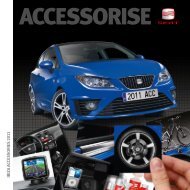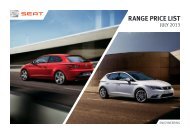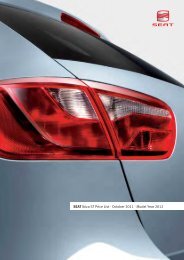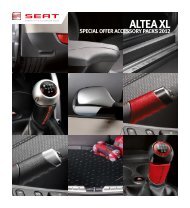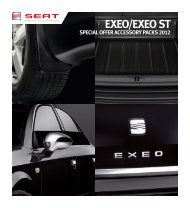WHAT'S THE DIFFERENCE BETWEEN STANDARD TYRES ... - Seat
WHAT'S THE DIFFERENCE BETWEEN STANDARD TYRES ... - Seat
WHAT'S THE DIFFERENCE BETWEEN STANDARD TYRES ... - Seat
You also want an ePaper? Increase the reach of your titles
YUMPU automatically turns print PDFs into web optimized ePapers that Google loves.
WHAT’S <strong>THE</strong> <strong>DIFFERENCE</strong> <strong>BETWEEN</strong><br />
<strong>STANDARD</strong> <strong>TYRES</strong> AND WINTER <strong>TYRES</strong>?<br />
ABOUT 11 METRES
BE PREPARED THIS winter<br />
Plummeting temperatures, difficult driving conditions and images of<br />
vehicles losing control and motorists being stranded are hard to forget.<br />
The heavy snow and icy roads are just part of the story – for five months<br />
temperatures can drop below 7°C on average and this is when the<br />
performance of standard tyres drops too.<br />
<strong>STANDARD</strong> <strong>TYRES</strong><br />
WINTER <strong>TYRES</strong><br />
Find out more about winter tyres<br />
for your SEAT at www.seat.co.uk<br />
Met Office statistics show 2010 was the coldest winter for over 30 years, with<br />
December being one of the coldest Decembers across the UK since 1910.<br />
And, last winter the Met Office recorded 147 separate days between<br />
October and March 2012 when temperatures dropped below 7°C during<br />
prime commuting hours in 10 major cities (measured from 7am till 9am<br />
and 4pm to 6pm).*<br />
Respected meteorologists predict that winter 2012/13<br />
will be very cold and exceptionally snowy<br />
Meteorologist James Madden, UK long range forecaster at Exacta Weather,<br />
correctly predicted the harsh conditions experienced in recent years.<br />
He believes the UK will see progressively worsening winters and forecasts<br />
well-below average temperatures – and this includes the upcoming winter<br />
of 2012/2013. Madden predicts the period December 2012 to January 2013<br />
may experience some of the coldest and snowiest conditions in at least a<br />
century at times.<br />
*Source: www.fleetnews.co.uk<br />
Image courtesy of NEODAAS/University of Dundee.
KEY facts<br />
7°C is the point at which you should<br />
consider switching to winter tyres<br />
The temperature is crucial to the performance of<br />
your tyres. When the temperature drops below<br />
7°C the tread compound in standard tyres begins<br />
to harden and gives you less grip, compromising<br />
the performance of your vehicle.<br />
In many European countries more accustomed to<br />
colder temperatures, it’s compulsory to fit winter<br />
tyres and fines may be issued if they’re not fitted.<br />
Average daily temperatures UK 1971-2000<br />
12.5<br />
DEGREES CELCIUS<br />
0<br />
6.0<br />
8.8<br />
3.0<br />
6.9<br />
1.5<br />
0.7 0.6<br />
OCT NOV DEC JAN FEB MAR<br />
Source: MET Office. http://www.metoffice.gov.uk/climate/uk/averages/19712000/areal/uk.html<br />
6.1<br />
With the UK experiencing temperatures below<br />
7°C for nearly six months of the year there is<br />
growing recognition that drivers here should<br />
seriously consider fitting winter tyres from<br />
October to March – for increased safety and<br />
improved vehicle performance.<br />
6.3<br />
9.3<br />
2.4<br />
Maximum temperature<br />
Minimum temperature<br />
What’s different about winter tyres?<br />
Winter tyres are made with a higher natural rubber<br />
content that keeps tyres soft and flexible even in<br />
the colder weather conditions. They have a<br />
different tread pattern which maintains their highly<br />
effective contact with the road for greater traction.<br />
A squarer shoulder profile with defined shoulderblocks<br />
helps winter tyres pull through tough<br />
conditions like ice and snow. The addition of sipes<br />
gives winter tyres extra ‘edges’ to grip, even on<br />
the most slippery surfaces.<br />
The World Meteorological Organization<br />
(WMO) requires the calculation of<br />
averages for consecutive periods<br />
of 30 years, with the latest covering<br />
the 1961–1990 period. However,<br />
many WMO members, including the<br />
UK, update their averages at the<br />
completion of each decade. 30 years<br />
was chosen as a period long enough to<br />
eliminate year-to-year variations.<br />
The latest set of 30-year averages<br />
on the Met Office website covers the<br />
period 1971-2000.<br />
<strong>STANDARD</strong> TYRE SUITABILITY<br />
above 7° below 7°C<br />
WINTER TYRE SUITABILITY<br />
below 7°C<br />
Dry roads ✔ ✔ ✔<br />
Wet roads ✔ ✔ ✔<br />
Optimum comfort/low noise ✔ ✘ ✔<br />
Optimum wear/mileage ✔ ✘ ✔<br />
Snow ✘ ✔<br />
Ice ✘ ✔<br />
Sipes<br />
A high number of sipes create a<br />
multitude of biting edges that<br />
interlock with the wintry surface,<br />
enhancing traction, improving<br />
braking performance and reducing<br />
wheelspin.<br />
Tread pattern and grooves<br />
The tread pattern on a winter tyre<br />
is particularly effective on snow,<br />
ice and slush. Snow sticks to itself<br />
better than rubber – narrow channels<br />
between the blocks trap snow in the<br />
tread, where it can ‘stick’ to the snow<br />
on the road.<br />
Tread compound<br />
At 7°C and below the tread compound<br />
in winter tyres remains flexible and<br />
grippy thanks to a higher natural<br />
rubber content.
KEY facts<br />
Why are winter tyres safer below 7°C?<br />
Winter tyres significantly improve grip and reduce<br />
stopping distances in temperatures below 7°C<br />
because, unlike standard tyres, they don’t<br />
harden. This enables them to maintain better<br />
traction in low temperatures, as well as in the wet<br />
and on snow, slush and ice, reducing the risk of<br />
aquaplaning and improving braking distance.<br />
Research undertaken by TyreSafe has clearly<br />
shown that stopping distances from 50mph on<br />
a cold, wet road are up to six metres shorter for a<br />
car using winter tyres compared with standard<br />
tyres – which is about the same length<br />
as a large family car.<br />
In snow, the difference between a winter tyre<br />
and a standard tyre is even more evident with<br />
stopping distances, braking and cornering<br />
performance all dramatically enhanced with<br />
winter tyres fitted. Stopping from just 20mph<br />
on an icy road can be improved by 11 metres –<br />
around the length of a bus.<br />
Don’t be put off by the additional<br />
COST of a second set of tyres<br />
The initial outlay is offset by the saving on<br />
wear to your standard tyres. Winter tyres wear<br />
up to 20% less than standard tyres during cold<br />
weather driving.<br />
(Source: www.tyresafe.org)<br />
Plus, if your tyres aren’t right for the conditions,<br />
your stopping distances are increased and<br />
you’re more likely to have an accident. If you<br />
claim on your insurance you could lose your no<br />
claims bonus – and the excess could be as<br />
much as the cost of a set of winter tyres.<br />
Use the right tyres for the conditions<br />
We advise against changing to winter tyres<br />
permanently as in warmer weather they’ll give<br />
you less grip, wear more quickly and lead to<br />
increased fuel costs.<br />
In some cases, the speed rating of the winter<br />
tyres fitted may be less than that of the standard<br />
tyres originally fitted.<br />
Braking distances on icy roads from 20mph (30km/h) to rest *<br />
WINTER <strong>TYRES</strong><br />
WINTER <strong>TYRES</strong><br />
<strong>STANDARD</strong> <strong>TYRES</strong><br />
<strong>STANDARD</strong> <strong>TYRES</strong><br />
57m<br />
57m<br />
11m<br />
11m<br />
68m<br />
68m<br />
Swapping to winter tyres<br />
between October and March<br />
will increase the lifespan of<br />
your standard tyres – saving<br />
you money in the long term.<br />
Winter tyre sidewall markings<br />
Severe snow<br />
conditions<br />
*Source: www.tyresafe.org<br />
Braking distances on snowy roads from 30mph (50km/h) to rest *<br />
35m<br />
WINTER <strong>TYRES</strong><br />
35m<br />
WINTER <strong>TYRES</strong><br />
<strong>STANDARD</strong> <strong>TYRES</strong><br />
<strong>STANDARD</strong> <strong>TYRES</strong><br />
8m<br />
8m<br />
43m<br />
43m<br />
<strong>STANDARD</strong> <strong>TYRES</strong><br />
WINTER <strong>TYRES</strong><br />
Mud and snow<br />
*Source: www.tyresafe.org
INDEPENDENT KEY facts<br />
Talk to your SEAT dealer about winter tyres<br />
Drivers are six times more likely to have an<br />
accident during the winter months, when there’s<br />
a sharp increase in insurance claims. With<br />
temperatures dipping below 7°C from October<br />
through to March, waiting for the first snowfall<br />
before switching to winter tyres may be too late.<br />
Using winter tyres throughout autumn and<br />
winter could help you avoid becoming another<br />
accident statistic.<br />
8,934<br />
SEAT is a member of TyreSafe, the leading tyre<br />
safety organisation, dedicated to raising<br />
awareness about the dangers associated with<br />
defective or illegal tyres. TyreSafe’s activities<br />
have helped reduce the number of people killed<br />
or seriously injured each year in a tyre-related<br />
accident by 30 per cent. This October, TyreSafe<br />
is launching Tyre Safety Month with important<br />
safety tips and winter driving advice:<br />
www.tyresafe.org/wintertyres/<br />
Winter weather tyres can be used all year round.<br />
However, in warmer conditions you may<br />
experience less grip and more rapid wear.<br />
The safest option is to switch to winter tyres in<br />
October and then back to standard tyres in the<br />
spring or March.<br />
Watch a car fitted with winter<br />
tyres in action to see the<br />
difference they could<br />
make to your SEAT<br />
this winter at<br />
www.seat.co.uk<br />
So you’ve read the facts and understand the<br />
safety and cost benefits that winter tyres offer<br />
you when temperatures drop below 7°C. Now your<br />
dealer can advise you on the right winter tyres for<br />
your SEAT and how you can make the most of the<br />
SEAT Winter Tyre Programme.<br />
A wideR range of leading tyre brands<br />
The SEAT Winter Tyre Programme offers you an<br />
extensive choice of winter tyres from brands<br />
including Goodyear, Dunlop, Firestone,<br />
Bridgestone and Continental.<br />
FREE Winter SAFETY Check<br />
with winter tyres from SEAT<br />
When you purchase winter tyres from SEAT and<br />
arrive at your local dealership to have them fitted,<br />
we’ll give your car a free Winter Safety Check<br />
(visit www.seat.co.uk). This inspection will be<br />
completed by our highly trained technicians and<br />
includes checking your wiper blades, antifreeze<br />
and screen wash levels and strength, light bulbs<br />
and tyre wear, and topping up your tyre pressures<br />
and vital fluids. It will help reduce the likelihood<br />
of an incident or breakdown during the cold<br />
conditions that are forecast for this winter, as well<br />
as highlighting any minor faults.<br />
Getting your winter tyres fitted<br />
When you bring your SEAT to your local<br />
dealership we’ll remove your standard tyres<br />
and put them in clear plastic bags. Once they’re<br />
bagged up we’ll discuss the best option to get<br />
these back to your home. Early in 2013 we’ll<br />
contact you to arrange replacing your winter tyres<br />
with your original standard tyres for when<br />
temperatures rise above 7°C.<br />
Ask your dealer about our tyre storage facility.<br />
Operated by our tyre programme supplier, it costs<br />
just £120 (inc VAT) for a 12-month period, including<br />
two periods of storage and two collections.<br />
2,434<br />
Number of accidents increases by<br />
267% during the winter months.<br />
(Source: http://conti-central.co.uk/winter-tyres/)<br />
“Whether roads are wet, frosty, icy or just dry and<br />
cold, winter tyres improve safety, reduce driver<br />
stress and help to protect no-claims bonuses, too.<br />
At 45°F (7°C) or less, winter tyres help to increase<br />
traction and reduce stopping distances. On average,<br />
most of Britain is this cold or colder for much of<br />
winter, according to the Met Office.”<br />
The Telegraph<br />
The following are extracts from Auto Express<br />
magazine’s winter tyre test in November 2010:<br />
“ Last winter was the worst for 30 years as record snowfalls and weeks of frozen roads brought<br />
the UK to a standstill – but it doesn’t have to be that way.”<br />
“ It’s difficult to believe how much more grip [winter tyres] offer over summer-spec tyres – turning a<br />
white knuckle ride on the edge of control to a regular journey, as if the snow or ice wasn’t there.”<br />
Auto Express concluded: “The clear winners here are cold weather tyres, which<br />
have a big advantage over the summer patterns used almost exclusively by UK<br />
drivers in the winter. In the snow, they offer a huge step up in grip and safety, and<br />
in the cold they outperform summer tyres.”<br />
See the complete test at www.autoexpress.co.uk/products/total_tyre_guide/
Get ready with winter accessories<br />
It’s worth thinking ahead to make sure you’re prepared with all the winter accessories and<br />
safety kit you’ll need for driving in the harsh conditions that are forecast this winter.<br />
Visit www.seat.co.uk for full<br />
details of accessories available<br />
for the SEAT range.<br />
WINTER CARE PACK (£15 RRP)<br />
Contains winter screenwash, windscreen<br />
de-icer, cockpit care, ice scraper and<br />
cleaning cloth – to help get you on the road<br />
safely with those cold morning starts.<br />
SPARE BULB<br />
AND FUSE kit<br />
Be prepared if you’re driving<br />
abroad this winter – spare bulbs<br />
are compulsory in some European<br />
countries. This kit contains a<br />
selection of bulbs and fuses.<br />
Engine<br />
Care<br />
A handy 1-litre Check-it Kit, containing<br />
everything you need to top up your oil<br />
between scheduled dealer visits, is<br />
available from your local SEAT dealer.<br />
Windscreen Washer<br />
Concentrate<br />
This is a concentrate with cleaning<br />
additives for windscreen washers.<br />
Windscreen<br />
De-icer AND<br />
Ice Scraper<br />
Concentrated de-icer with a fast<br />
acting formula, which quickly clears<br />
frost from your windscreen.<br />
A great value ice scraper – ideal for<br />
those cold and frosty mornings.<br />
Mudflaps<br />
Complete<br />
Safety Kit<br />
Travel Mug<br />
Umbrella<br />
Winter<br />
Screen Wash<br />
WAX<br />
Shampoo<br />
Car Polish<br />
Perfect<br />
Polishing<br />
Cloths (8-pk)<br />
SEAT has a range of mudflaps<br />
designed to protect your SEAT’s<br />
bodywork against mud, salt,<br />
stones and silt.<br />
In some European countries it’s a<br />
legal requirement to carry a safety<br />
kit, which includes a first aid kit,<br />
warning triangle, torch and highvisibility<br />
vest. The kit comes in a<br />
SEAT branded bag which secures<br />
in the boot of your car.<br />
This practical mug is the perfect<br />
solution for a warming drink on the<br />
move this winter.<br />
Don’t get caught without an umbrella<br />
to keep off the worst of the winter<br />
rain and snow – an essential item for<br />
every car boot.<br />
This screen wash cleans and<br />
protects against renewed frosting<br />
over, guaranteeing you a clear,<br />
smear-free screen throughout<br />
the winter months and beyond.<br />
Cleans and preserves in one go.<br />
For manual washing of paint with a<br />
drip-off effect. Cleans free of stripes<br />
and leaves behind a temporary gloss<br />
effect. Protects paint with high-grade<br />
regreasing components.<br />
Ideal for the winter, this car polish<br />
has a full paint care agent that’s<br />
resistant to weather and shampoo.<br />
It refurbishes dull paint surfaces,<br />
preserves and has a gloss-deepening<br />
and colour-freshening effect.<br />
One of the secrets of obtaining a<br />
perfect shine is to use the correct<br />
cloth. Autoglym Perfect Polishing<br />
Cloth has been specially developed<br />
with the correct density and absorbency<br />
for polishing fine surfaces. Cloths are<br />
hand washable and reusable.
We are Spanish and German. We are passionate perfectionists. We are emotional technologists.<br />
Everything we know is everything you feel. We give design purpose. We bring technology to life.<br />
We call it enjoyneering. We are SEAT.<br />
Your SEAT SERVICE Authorised Repairer<br />
SEAT SERVICE<br />
SEAT recommends Castrol EDGE Professional<br />
SEAT is committed to a policy of continuous product development and reserves the right to make changes to specifications,<br />
offers, products and prices without notice. The information in this brochure can therefore be given as guidance only. While<br />
SEAT makes every effort to ensure that information and prices are accurate at the time of publication (October 2012),<br />
you should always check with your SEAT SERVICE Authorised Repairer for the latest information. Available at participating<br />
repairers until 28 February 2013.






